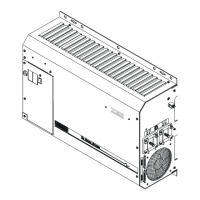OPERATION
Page
60
Copyright Trace Engineering Company, Inc.
5916 - 195th Street N.E.
Arlington, WA 98223
Telephone: 360/435-8826
Fax: 360/435-2229
www.traceengineering.com
PS Series Inverter/Charger
Part No. 3597
Rev. D: November 23, 1999
Successful operation of the system utilizing the search mode requires some initial tuning of the search mode
settings to match the loads connected in the system. If the loads change significantly, re-tuning of the
settings may be required. The benefit of the search mode circuit only is realized if the inverter is able to
enter the energy saving search mode for substantial periods of the day. Occasional checking of the yellow
INVERT LED (INVERTING LED on the SWRC) operation should be done to ensure that the search mode is
being used when all of the loads are turned off (it should blink slowly if it is searching for a load).
SETTING SEARCH MODE WATTS (REQUIRES THE SWRC)
The search mode is user adjustable to allow fine-tuning of its operation. The settings are located under
the INVERTER SETUP (9) menu heading in the SETUP MENU. The following example explains the
operation:
Example: With the SEARCH WATTS setting at 32, a 50-watt load will bring the inverter to full output
voltage. However, a 30-watt load will leave the inverter in its energy saving search mode. If the sensitivity
is increased by lowering the setting to 16, a 20-watt load will bring the inverter out of the search mode,
while a 5-watt load will not.
When in the search mode, the yellow INVERT LED (INVERTING LED on the SWRC) will blink slowly and
the inverter will make a ticking sound. At full output voltage, the yellow INVERT LED (INVERTING LED on
the SWRC) will stay on and the inverter will make a steady humming sound. When the inverter is used as
an uninterruptable power supply, the search mode should be defeated.
Exceptions: (Murphy's Law) Unfortunately, things don’t always work the way the manual says.
Example A: If the SEARCH WATTS is set at 32 and a 30-watt incandescent light is turned on, the
inverter will detect the light. The initial load of the bulb is much greater than 32 watts when its filament is
cold. When the light gets bright, the filament heats up and the light becomes a 30-watt load. Since this is
below the setting of 32, the inverter will not detect it and the light will turn off. This can cause cycling of
the inverter between on and off.
Example B: If the SEARCH WATTS setting is 32 and a 40-watt florescent light is turned on, the inverter
will not detect the light. The light presents a smaller load than 32 watts until the gas in the florescent tube
ionizes and begins to glow. This problem is more common with the non-electronic type fluorescent bulbs.
Example C: There are some appliances that draw power even though they are turned off. TVs with
instant on circuits, microwave ovens with digital displays and VCRs with clocks are examples. These
loads can present a dilemma. If the SEARCH WATTS is set higher than the combination of these loads,
then an additional load must be used to bring the inverter out of the search mode before the appliances
can be turned on. If the SEARCH WATTS is set lower than this combination of loads, then the inverter
and the loads will be left on. This will put an additional drain on the batteries (three such 15-watt loads
would amount to an additional 45 amp/hours per 24 hours in a 24 VDC system). One solution is to turn
these items off by using an extension cord with a rocker switch, a switched outlet, or a circuit breaker for
the circuit. Unfortunately, this solution does not allow a clock to retain its setting and may cause it to blink
constantly while operating.
SETTING SEARCH MODE SPACING
The SET SEARCH SPACING menu item is calibrated in cycles. To test for loads once each second,
adjust this setting to 59 (for 60 Hz models); to test for loads about twice a second, adjust the setting to 30.
NOTE: The lower the search spacing value – the less time it takes for the inverter to bring up a load. The
lower the setting), the greater the power consumption while in the search mode, thus reducing power.
The factory default value (59) is acceptable for most applications. The range is from 4 to 255.

